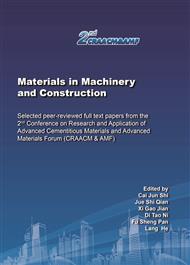[1]
Y. Wang, Development Schedule and Criterion of Talent Training System for Semiconductor Lighting Industry Guangzhou: SUN YAT-SEN UNIVERSITY PRESS. (2017) 1-17.
Google Scholar
[2]
C.B. Huang, Y. Wang, B. Peng, Study of Fabrication and Application of the Non Visual Hazard LED Materials Report, Nano and new materials album (2) 311-315.
Google Scholar
[3]
D. Roberts, Artificial lighting and the blue light hazard (The facts about lighting and vision) MD Support, (2011) 1-38.
Google Scholar
[4]
H. Kim, H. Kim, C.H. Jung, I. Yoon, A Method for Reducing Blue Light Hazard from White Light-Emitting Diodes Using Colorimetric Characterization of the Display, International Journal of Control and Automation. 8 (2015) 9-18.
DOI: 10.14257/ijca.2015.8.6.02
Google Scholar
[5]
W. He, C.Y. Yang, Spectral Contrast and Comprehensive Effect Analysis of Fluorescent and LED in University Classrooms Light & Lighting. 042 (2018) 51-55.
Google Scholar
[6]
C.B. Huang, Research on high color rendering and high luminous efficiency biosafety LED light source, Wuyi University (2015) 8-12.
Google Scholar
[7]
H.T. Chen, Z. Cai, X.C. Wu, Radiance and Ocular Hazards of Extended Sources China Illuminating Engineering Journal. 23 (2012) 43-57.
Google Scholar
[8]
W.H. Guo, T. Zhang, S.D. Yuan, Blue light hazard and its measuring method Chinese Optics (2018) 51-60.
Google Scholar
[9]
T.M. Katona, P.M. Pattison, S. Paolini, Status of Solid State Lighting Product Development and Future Trends for General Illumination, Annu. Rev. Chem. Biomol. Eng. 7 (2016) 263-281.
DOI: 10.1146/annurev-chembioeng-080615-034625
Google Scholar
[10]
Y. Qian, Different morphologies of YAG phosphors in white LED packaging China Integrated Circuit. 24 (2015) 65-68.
Google Scholar
[11]
C. Xu, Z.H. Zheng, J. Luo, Analysis of influence factors of white LED phosphor precipitation Automation & Information Engineering. 38 (2017) 16-20.
Google Scholar
[12]
X.L. Wan, A STUDY ON PHOSPHOR COATING STRUCTURE AND PROCESSES FOR WHITE LED University of Electronic Science and Technology of China. (2014) 9-31.
Google Scholar
[13]
X.B. Luo, J.J. Zhang, B. Xie, Spectra Design and Packaging Optimization for White Light-emitting Diodes with High Luminous Efficiency and Color Performance Beijing: Science Press, (2018) 3-10.
Google Scholar
[14]
B.Q. Li, L.Y. Yu, M.H. Luo, Effect of Precipitation of Phosphor on COB LED Light Color Parameters Semiconductor Optoelectronics. 39 (2018) 824-827.
Google Scholar
[15]
J.H. Yum, S.Y. Seo, S. Lee, Y3A15O12: Ce0.05 Phosphor coatings on gallium nitride for white light emitting diodes Electro-chem. Soc. 150 (2003) 47-49.
DOI: 10.1149/1.1535207
Google Scholar
[16]
Burgess. LED update: Alternate packaging improves white LEDs Photonics Spectra, 39 (2005) 118-119.
Google Scholar
[17]
X.J. Wang, Y.L. Duan, T.S. Mou, The Evaluating Method of Healthy Lighting and Its New Development of Standardization China Illuminating Engineering Journal. 28 (2017) 29-34.
Google Scholar
[18]
Q. Li, Y. Xin, Advancement and Trends of Full Spectrum LED China Light & Lighting. (2017) 12-16.
Google Scholar
[19]
K. Smick, T. Villette, M.E. Boulton, Blue light hazard: New knowledge, new approaches to maintaining ocular health Report of a roundtable sponsored by Essilor of America. (2013) 1-12.
Google Scholar
[20]
Y.H. Qin, Preparation and research of high quality healthy LED light source Beijing, Beijing Jiaotong University (2019) 15-18.
Google Scholar
[21]
J.H. Zhang, Y. Yi, J.E. Mai, Study on Healthy Lighting Spectra and LED devices China Light & Lighting. (2019) 8-12.
Google Scholar
[22]
National Technical Committee for the standardization of lighting appliances. Luminaires-part 1: General Requirements and tests:GB7000.1-2015. Beijing: China Standard Press (2015).
Google Scholar
[23]
Shenzhen LED Industry Standard Alliance. Indoor health lighting design specification first part: Full spectrum technology requirements: SZTT/LSA024.1-2019 (2019).
Google Scholar
[24]
B.Q. Li, M.H. Luo, L.Y.Yu, Full spectrum LED light in COB package and its characteristics Chinese Journal of Liquid Crystals and Displays. 33 (2018) 30-34.
DOI: 10.3788/yjyxs20183311.0931
Google Scholar


